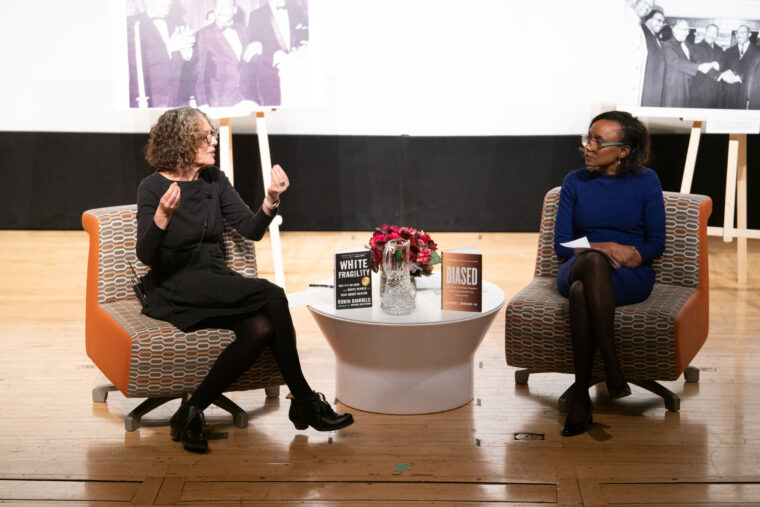Writers & Readers: Eberhardt and DiAngelo Discuss Racism, White Fragility (Recap)
Bias influences everything from who we see as suspicious in our neighborhoods to our hiring and promotion decisions to who jurors sentence to die. Jennifer Eberhardt, Ph.D. On Saturday, February 8, authors Robin DiAngelo, Ph.D., and Jennifer Eberhardt, Ph.D., came together in a timely conversation about racism and white fragility as part of Cleveland Public […]


Bias influences everything from who we see as suspicious in our neighborhoods to our hiring and promotion decisions to who jurors sentence to die.
Jennifer Eberhardt, Ph.D.
On Saturday, February 8, authors Robin DiAngelo, Ph.D., and Jennifer Eberhardt, Ph.D., came together in a timely conversation about racism and white fragility as part of Cleveland Public Library’s Writers & Readers series. More than 400 people gathered in Cleveland State University’s Berkman Hall to hear Eberhardt and DiAngelo’s frank discussion surrounding the realities of bias and racism in contemporary American culture.
“Our minds are shaped by racial disparities and how we make sense of those disparities,” Eberhardt said. “But we need not accept those narratives.”
In her book, Biased: Uncovering the Hidden Prejudice that Shapes What We See, Think, and Do, Eberhardt, a social psychologist at Stanford University, explores the prevalence and power of bias in our culture. Through exhaustive research, Biased outlines how racial bias affects perception. For example, Eberhardt revealed that when people are exposed to images of black faces, they’re more likely to support punitive jail sentences, and they’re also more quickly able to identify blurred images of guns.
“Bias influences everything from who we see as suspicious in our neighborhoods to our hiring and promotion decisions to who jurors sentence to die,” Eberhardt explained. “My hope is that readers will learn how they can participate in that fight [against bias] and to see the world in a different way.”
Denial and Defensiveness
In White Fragility: Why It’s So Hard for White People to Talk About Racism, DiAngelo, a University of Washington professor specializing in Whiteness Studies, set out to push fellow white people to confront their own racism—and to understand, first and foremost, that racism is deeply embedded in our very culture. Racism, she said, circulates 24 hours a day, 7 days a week, 365 days a year.
“Nothing exempts anyone in this room from the messages and advantages of racial hierarchies we live in,” DiAngelo said. “Yes, we’re all biased, but racism is what happens when you back one group’s collective bias with power. I’m trying to get every single white person in this room out of denial. I want white people to get in touch with their racist conditioning.”
Most white people, DiAngelo continued, are conditioned to believe that to be “racist” is to consciously judge and mistreat others based on race. They see racism as wholly “bad,” which means a “good” person cannot be racist. So long as a white person does not intend to be racist, the fallacy goes, their racists actions or comments don’t count. This is the kind of thinking DiAngelo is trying to dismantle.

“We grow up learning that prejudice is bad, which is actually an effective way to protect systemic racism,” she explained. In reality, a person can be progressive and well-meaning but also inflict harm based on the racist ideologies they have been immersed in their entire lives.
DiAngelo and Eberhardt discussed the challenge of encouraging white people to address their own racism. DiAngelo coined the term “white fragility” to describe “how little it takes to cause white people to melt down” in the face of these discussions.
“There’s a belief that if you notice discrimination, you’re a racist,” Eberhardt added. “Young children are taught not to talk about race in mixed company—as if by not mentioning it, you can never be biased.”
Wake-Up Call
If you are a white person and have not devoted years to this topic, your opinions are limited and superficial.
Robin DiAngelo, Ph.D.
One takeaway for the white audience members at this Writers & Readers event was to acknowledge their own inherent racism, to listen when people of color offer feedback on their racist behavior, and to remember that good intentions do not counteract perceived racism. To reflect critically on these issues, and to acknowledge that yes, even (and especially) well-meaning progressive are implicated in our racist culture, is perhaps a first step toward growth.
DiAngelo also stressed that it’s for people of color to decide in any given moment if white people are acting in racist ways. White people are not the authorities of racism—including their own.
“If you are a white person and have not devoted years to this topic, your opinions are limited and superficial,” she warned.

Finally, when it comes to fighting back against bias and racism, DiAngelo urged white people to do this work themselves (“Look it up!” she said) and to not rely on people of color to do it for them. She recommended starting with Layla F. Saad’s workbook, Me and White Supremacy: Combat Racism, Change the World, and Become a Good Ancestor. She also advised white audience members to go home, take out a sheet of paper, and write down why they don’t understand or haven’t yet addressed their own racism. Doing this, she said, can provide a map of how to move forward.
“It’s a lifelong endeavor for me as a white person to continually try to unpack [my racism],” she said. “I’m never going to be finished. I’m never going to have arrived.”
